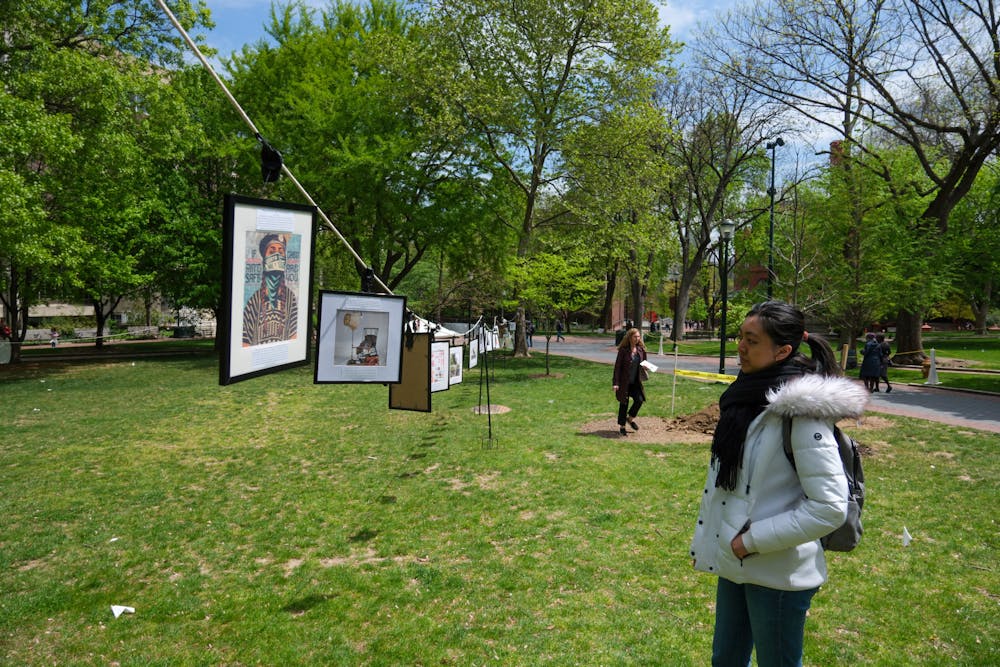
Penn Reproductive Justice held an art exhibition on College Green on April 25 about the inequalities within reproductive justice, focusing on issues such as abortion, immigration, and racial discrimination.
The exhibition spotlighted artists from West Philadelphia, aiming to highlight the voices of marginalized communities. It included paintings, photographs, and written artwork displayed around the green for the public to view.
College senior Neha Shetty, one of the founders of PRJ, said that she helped create the group in 2022 in the wake of Roe v. Wade being overturned, in order to fill a gap in the Penn community advocating for women’s reproductive rights.
“All of our work is community based and community sourced,” Shetty said.
College sophomore Keira Feng, an organizer of the exhibition, said that she joined the club due to her experience working in women’s shelters in high school.
“Women over the city were living in dire conditions, and lacked a lot of basic supplies,” Feng said. “At Penn, I really wanted to be a part of an organization that advocated for women’s access to healthcare."
College first year Evelyn Liu, another organizer, said that in order to realize their vision of an exhibition, the group reached out to many freelance artists, as well as organizations at Penn such as Quake Magazine.
“It took a lot of scouring and digging deep,” Liu said. “We went down a rabbit hole while reaching out to artists.”
One of the most prominent pieces featured was a painting titled “Black Mamas Reclaim Their Space in Reproductive Justice” by Philadelphia-based Afro-pop artist Cozcon, depicting a Black woman standing on an open pearl in a modern rendition of “The Birth of Venus” by Botticelli. Shetty said that the artwork draws attention to the crucial role of Black women in founding the reproductive justice movement.
“It’s important to uplift the voices that have been forgotten and silenced,” Shetty said. “That is the Black community.”
The piece “Mothers of Gynecology” illustrates the surgeries conducted on Black women by physician J. Marion Sims during the 19th century. Sims was a well-known gynecologist who experimented with surgical techniques on enslaved women, operating on them without anesthesia in his office in Montgomery, Alabama.
“[Sims] is unfortunately called the 'father of modern gynecology,'” Shetty said. “But he continued his surgeries even when his subjects would say they are in excruciating pain.”
Shetty said that the work draws attention to the larger misconception that Black people experience less pain, leading to injustices towards them in reproductive health.
The exhibition also featured two pieces discussing the reproductive injustices occurring in Palestine as a result of the war in Gaza. The first one, a compilation of photographs by multiple artists, was titled “Reproductive Justice in the Context of Palestine” and depicted young children and mothers.
“There is a complete reproductive justice genocide going on in Palestine,” Shetty said. “It is immoral to create this reproductive justice exhibition without including this perspective.”
According to Shetty, three human rights pillars form the basis of reproductive justice: the ability to safely choose not to have children, the right to have children under chosen circumstances, and the ability to have children in a safe environment. However, Shetty said that what is currently happening in Palestine does not encompass any of these three values.
The second piece, titled “Art from Children in Palestine,” was curated by multiple artists and featured a compilation of pictures of plates that were made by young children in Palestine. The plates depict daily activities, such as playing games with peers or eating.
“Who knows how many of the kids that created this are still alive,” Shetty said.
Another piece, titled “Sexual violence is the norm for women crossing the U.S.-Mexico border,” depicted the topic of reproductive injustice in immigration. The photograph by David McNew portrayed immigrants with their heads downcast against a metal barrier. According to Shetty, people do not talk enough about the lack of reproductive autonomy and safety that immigrants experience.
“People who are experiencing this are in such a weak position politically,” Shetty said. “They are trying to get into the country they are being assaulted by.”
Considering the breadth of topics that the exhibition covered, a main takeaway that Shetty shared is her desire to raise awareness about marginalized and vulnerable groups.
“There are so many identities that are completely shut out and not brought to the surface,” Shetty said. “As we’ve curated this exhibition, I wanted to include a lot of diverse perspectives.”
The Daily Pennsylvanian is an independent, student-run newspaper. Please consider making a donation to support the coverage that shapes the University. Your generosity ensures a future of strong journalism at Penn.
Donate







